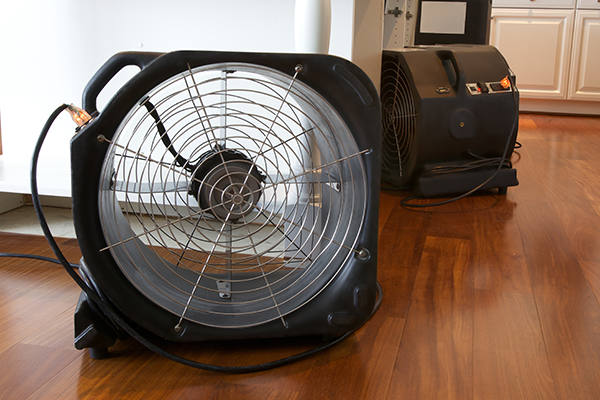
Mold is every homeowner’s worst nightmare. Not only is it extremely damaging to your health, but it can also eat away at your home and lead to costly repairs over time. And, after exposure to water, it only takes 24 hours for mold to start growing.
If you’ve recently had a flood, leak, or other type of major water intrusion, it’s important that you take quick action to protect your home and health. Here are some steps you can take to prevent mold after water damage, what signs of mold to watch for, and when you should call a professional for help.
1. Assess the Situation
Whether a pipe broke, an appliance started leaking, or the rainy weather managed to seep indoors, large amounts of water is incredibly damaging—and in some cases, dangerous. Before leaping to action, take these important steps:
- Examine the water: If you’re dealing with relatively clean water, like a leaky water supply pipe or water heater, you may be able to handle the problem on your own. For floods that have to do with wastewater, attempting to do so could put your health at serious risk. Always contact a professional if you believe the water may be contaminated.
- Look for electrical devices: Without coming into contact with the water, try and see if there are any electrical outlets or devices that may be touching it. If you notice any potential safety hazard, do not touch the water and call a water remediation company for advice immediately.
- Wear protective equipment: You may not see every safety hazard just by looking from a distance. Prior to getting wet, make sure you wear rubber-soled boots or gloves that may protect you from electrical shock.
- Determine whether you can remove the water on your own: Most people can remove small amounts of water on their own. However, if you’re dealing with a huge flood or leak that’s left your entire floor covered, it may be too big a project to handle on your own. Honestly assess the situation and decide whether it’s something you want to tackle without professional equipment.
2. Fix the Source of the Water
It’s pretty much impossible to get rid of standing water if more keeps pouring in. Take a look around for the source of your leak or flood. Some common places to look include:
- Broken pipes
- Leaking appliances, like washers or water heaters
- Clogged sump pumps
- Cracks in your foundation
If you’re able to locate the problem, try patching it or repairing it to stop the flow of water. If you’re unable to find the source of the water or can’t get it to stop leaking, you may need to call a handyman for help.
Emergencies Can't Wait - Neither Should You!
Click below, let us know how to reach you, and we'll call you soon!
Get Immediate Help Today!
We'll respond to the site in 90 minutes or less.
3. Remove the Excess Water
Once the water has stopped flowing into your home, it’s time to remove as much excess water as possible. The more you remove during this step, the faster your space will dry out, which will make it easier to prevent mold.
Small puddles are pretty easy fixes; just place some towels down to mop it all up. For larger leaks, you may have to use some equipment like a shop-vac to suck up all of the water. To do so, remember to remove the air filter so the water can flow in easily without clogging your equipment.
If you don’t own a shop-vac or are worried there’s too much water for it to handle, it may be best to call a water damage repair company. Experts have access to a wide variety of equipment that can handle a larger volume, and they’ll be able to tackle more complex situations like wet carpet.
4. Reduce Humidity
Even with the majority of the water gone, your room will still have enough moisture in it to prompt mold growth. Reducing humidity is a key step to protecting your space after a flood or leak. Ways to reduce humidity and prevent mold after water intrusion include:
- Run a dehumidifier as soon as possible
- Remove wet furniture, rugs, or other fabric
- Consider pulling back and replacing wet carpet
5. Sanitize the Area
Though sanitizing isn’t a reliable way to get rid of mold on its own, it is still important after a flood. Even if you aren’t dealing with wastewater or other severely contaminated leaks, most floodwater is still dirty and may pose a health risk. Always disinfect the affected areas, including the walls and flooring.
How Professional Water Damage Repair Can Help
Dealing with a flood in your home can be stressful, and poor response could lead to some serious long-term problems—mold growth is just one of them. Water damage restoration experts know how to safely and thoroughly extract the water, dehumidify the area to stop mold, and disinfect it to keep your space as hygienic as possible. Not only that, but they can quickly repair any damage to its pre-flood condition.
At BCC Restoration, we’ve proudly protected homeowners throughout Vancouver WA from the dangers of water intrusions. Our technicians offer fast response times to minimize damage as much as possible, and we’ll walk you through every step of the restoration process to make it as stress-free as possible. If you have questions or are dealing with a flood emergency, give us a call now.
Back to Water Damage Restoration – RepairHow to Prevent Mold After Water Damage in Portland OR - Vancouver WA
Serving Vancouver WA and Portland OR
Camas | Washougal | Ridgefield | Woodland | Battle Ground | Gresham | Beaverton | Hillsboro | La Center
Hockinson | Amboy | Hillsboro | Beaverton | Tigard | Gresham | Woodburn | Salem
Home » Water Damage Restoration – Repair » How to Prevent Mold After Water Damage
